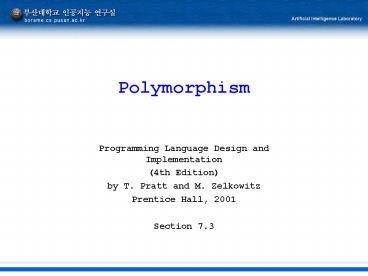Polymorphism - PowerPoint PPT Presentation
Title:
Polymorphism
Description:
The use of parameters to subprograms is one of the oldest ... fun thing(x::y) = truncate(x) hd(y); fun thing(x::y:int list) = x hd(y); Polymorphism ... – PowerPoint PPT presentation
Number of Views:58
Avg rating:3.0/5.0
Title: Polymorphism
1
Polymorphism
- Programming Language Design and Implementation
- (4th Edition)
- by T. Pratt and M. Zelkowitz
- Prentice Hall, 2001
- Section 7.3
2
Polymorphism
- The use of parameters to subprograms is one of
the oldest characteristics of programming
languages - But they have an l-value. That is, they are a
data object that requires storage. - Polymorphism means a single operator or
subprogram name can to refer to any of a number
of function definitions depending on the data
types of the arguments and results. - Similar to overloading
- It is generally applied to functions where a type
is one of the arguments.
3
Polymorphism in ML
- reverse(1,2,3)
- val it 3,2,1 int list
- reverse(1.0, 2.0, 3.0)
- val it 3.0,2.0,1.0 real list
- reverse(1,2,3, 4,5,6, 7,8,9
- val it 7,8,9,4,5,6,1,2,3 int list
list - Arguments to reverse are different list data
types - fun identity(x) x
- fn 'a -gt 'a
- identity(1)
- val it 1 int
- identity(1.5)
- val it 1.5 real
- But why is the following not polymorphic (or
legal) in ML? fun add(x,y) xy?
4
Type inference in ML
- ML is strongly typed, but if it can infer a type,
it does not need an explicit type declaration - fun add(xint, yint)int xy
- add is fully qualified. Any one declaration
defines the operation. - All are equivalent
- fun add(xint, y) xy
- fun add(x, yint) xy
- fun add(x, y)int xy
- But fun add(x, y) xy is ambiguous
- At runtime, function is well defined, but ML uses
static type inferencing to determine function to
invoke before execution.
5
Type inference examples
- ML does not allow automatic coersions between int
and real, so what are signatures (if any) to the
following? - fun add(x,y) real(x) y
- fun thing(xy) x hd(y)
- fun thing(xy) truncate(x) hd(y)
- fun thing(xyint list) x hd(y)
6
Polymorphism in arrays
- Note Implementation of arrays differs in most
languages - Pascal - arrays are explicit and bounds are part
of type. Not polymorphic. - type matrix10 array1..10 of integer
- var x matrix10
- Ada - polymorphic array bounds
- type matrix is array (integer range ltgt) of
integer - y matrix(1..30)
- C arrays don't really exist - shorthand for
pointer variables. - int C10
- C5 means C5
7
Create polymorphism
- Can often build parameterized objects for true
polymorphism, e.g., stack of objects - Y stack(int, 10) ? up to 10 ints
- Z stack(float, 20) ? up to 20 reals
- Can do this in ML and Ada for any data types that
don't involve calculations (i.e., only for
operations that use pointer manipulation
(stacking and unstacking) - Why?
- Macros can be used to simulate this for languages
without polymorphism, e.g. In Pascal - sum(int,A,B) ? can be implemented as a macro with
4 sequences depending upon types of arguments - trunc(A)B
- Atrunc(B)
- AB
- trunc(A)trunc(B)
8
Implementation
- For statically typed languages (ML, C),
polymorphism is easy Keep track of function
argument types in symbol table of compiler. - For dynamically typed languages
- Two forms of arguments can be passed to a
polymorphic function - 1. An immediate descriptor - when the value to a
function is smaller than the size of the fixed
field. For example, passing a Boolean, character,
or small integer to a function uses less space
than the fixed-size object permits. The actual
value is placed in the argument location, and the
extra bits in the field are used to tell the
function what the type actually is. - 2. A boxed descriptor occurs in all other cases.
9
Boxed descriptors
- The argument field will contain a type indicator
stating the argument is boxed. - The rest of the field will be the address of the
actual object (which will be elsewhere, such as
in heap storage). - At this address, the complete type information
will be given, such as giving the entire
structure of the composite data object.
10
Example of dynamic polymorphism
- Assume argument descriptor field is 5 bytes.
- Byte 1 is a data type indicator and Bytes 2 to 5
are the data. - The following arguments can be passed to a
polymorphic function - 1. 32-bit Integer data. Byte 10 signifying
integer, bytes 2 to 5 are the 32-bit integer
value. - 2. 8-bit character data. Byte 11 signifying
character, byte 2 actual character argument,
bytes 3 to 5 unused. - 3. 1-bit Boolean data. Byte 12 and byte 2 0 or
1. - 4. Complex record structure. Byte 13 and bytes 2
to 5 are pointer to structure. The r-value at
this pointer address contains more information
about the actual argument.
11
(No Transcript)































